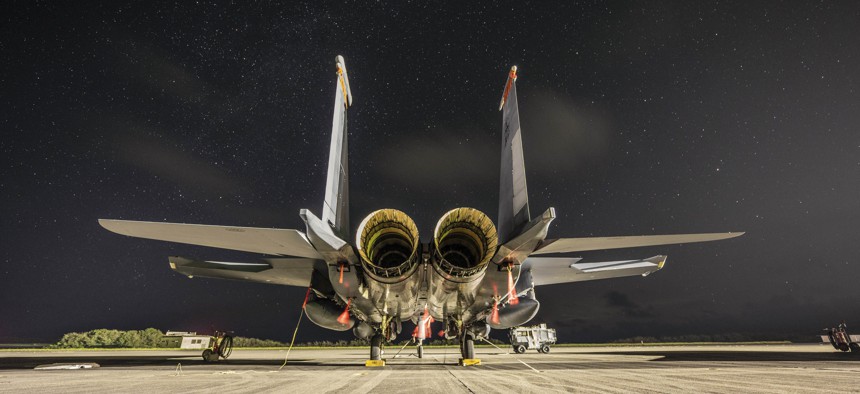
An Air Force F-15E Strike Eagle sits on the flight line during Northern Edge in Iwo To, Japan, July 10, 2023. U.S. Air Force / Airman 1st Class Alexandria Byrd
Congress may stymie Air Force plan to start retiring F-15Es
The service aims to save $2.9 billion by getting rid of 119 fighter jets.
Lawmakers are pushing back on an Air Force plan to begin shedding 119 F-15Es next year.
The service wants to start retiring F-15E fighters with older engines in 2025 and only keep 99 Strike Eagles with newer engines.
But Sen. Ted Budd, R-N.C., filed an amendment to the Senate’s version of the annual defense policy bill that would prevent the Air Force from spending any money from fiscal years 2024 to 2029 that “may be obligated or expended to divest any F-15E aircraft.” The senator’s state is home to an F-15E fighter wing at Seymour Johnson Air Force Base.
An Air Force Department spokesperson said they won’t have any details about the plan to begin retiring F-15Es in 2025 until President Biden submits his budget to Congress early next year. However, the spokesperson said, “In our continued efforts to build a capable, sustainable, and affordable future fighter fleet, the FY-24 president’s budget proposed retirement of F-15 C/Ds as well as plans to divest less capable F-15Es in the later years of the Future Years Defense Plan.”
While some members of Congress are skeptical of the Air Force’s plans for F-15Es, lawmakers are set to greenlight the service’s request to retire 57 F-15C and D fighter jets in 2024.
The Air Force told Congress F-15Cs and Ds can’t survive in a fight against China, but hasn’t made that same case for F-15Es, one congressional aide said. Instead, lawmakers believe the move to retire these aircraft is primarily intended to save money, the aide said, since getting rid of all 119 fighters would save the Air Force about $2.9 billion.
Even as the service makes plans to get rid of the F-15Es, it is working to finish equipping all of them with a new electronic warfare suite, called Eagle Passive/Active Warning and Survivability System, or EPAWSS. The jets have also been updated with an advanced radar.
With new radars and an electronic warfare overhaul, F-15Es are “the most advanced fourth-generation fighters in the world with years of service left,” Budd said during the July 11 hearing on Air Force Chief of Staff Gen. CQ Brown’s nomination to be the next chairman of the Joint Chiefs of Staff.
Brown says the Air Force wants to cut F-15Es to modernize the force and balance capability and capacity. Staying ahead of the adversary isn’t just about having more numbers, he said at the hearing, it’s about investing in the capabilities that make the service’s fighters more relevant.
“As we do this, it's not just the platforms themselves, it's the other aspects of our command and control in terms of bringing some reconnaissance capabilities that we will continue to invest in to bring those forward to make each of the platforms we have more capable,” the general said.
The service plans to backfill the fleet with new F-15EXs, procuring 24 F-15EXs in both 2024 and 2025, for an eventual fleet size of 104.
F-15Es are some of the Air Force’s newest fighters, after F-22s and F-35s, said Dave Deptula, a retired Air Force three-star and current dean of the Mitchell Institute.
“Given the decline in the size of the USAF force structure over the next five years, it would be prudent to retain these aircraft at least until they can be backfilled by the F-15EX,” Deptula told Defense One.
Budd’s amendment will likely be added to the Senate’s version of the annual defense policy bill, which is currently in its second week of debate on the floor.
The House version of the bill, which narrowly passed earlier this month, does not have a similar provision to Budd’s amendment.
Asked about the likelihood of this being added to the National Defense Authorization Act, Chairman of the House Armed Services’s tactical air and land forces subcommittee Rep. Rob Wittman, R-Va., said he looks “forward to discussions with the Senate on better options to pursue a more ready Air Force fighter force structure.”
Wittman added he is “opposed” to the Air Force’s divest-to-invest strategy.



